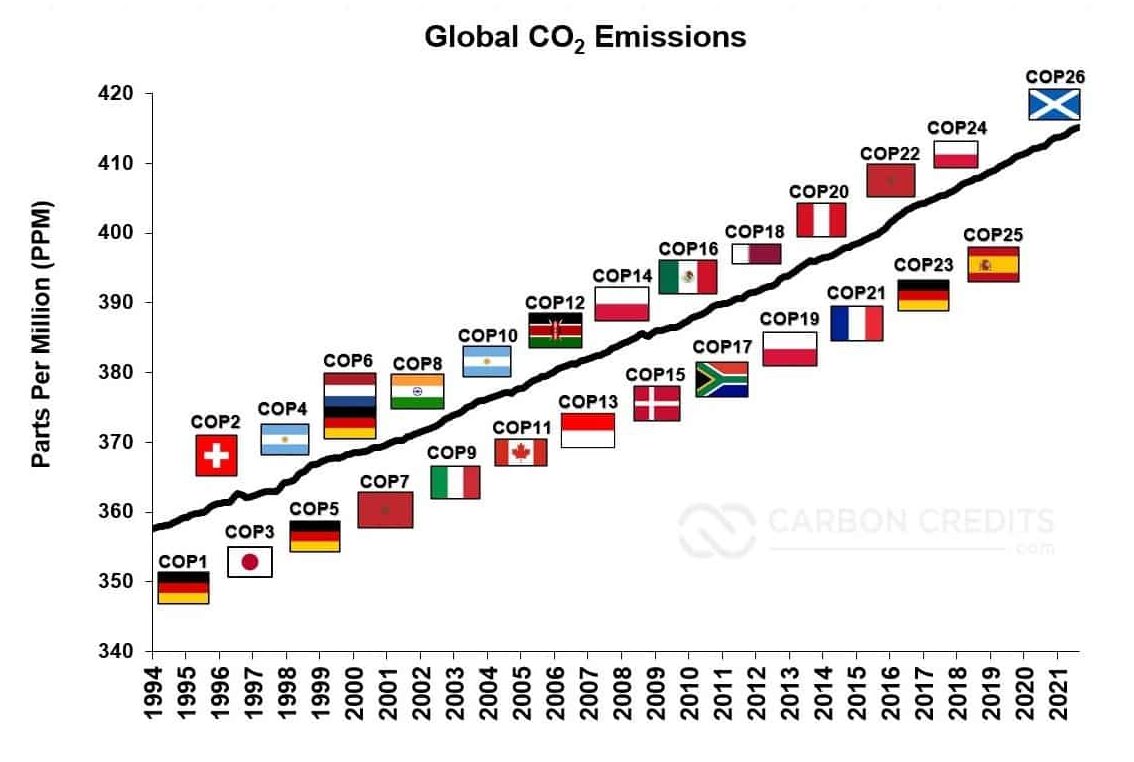The Supervisory Body overseeing Article 6.4 of the Paris Agreement has recently released a preliminary draft document outlining proposed methodologies for carbon reduction projects. This is important as the most anticipated climate conference, COP28, will take place starting this November 30 in Dubai.
The methodologies are integral for projects aiming to claim Article 6.4 emission reduction credits, also called 6.4 ERs. The focus of the draft recommendation centers on the requirements set for projects aimed at curbing greenhouse gas (GHG) emissions.
Supervising “The Mechanism”
The Conference of the Parties (COP), serving as the meeting of the Parties to the Paris Agreement (CMA), during its 3rd session held in Glasgow, made a significant decision by adopting Decision 3/CMA.3. The COP timeline is shown below, alongside the rising global carbon emissions.

In line with this decision, the CMA has appointed a Supervisory Body responsible for overseeing and administering the mechanism. It operates under the authority and guidance of the CMA.
The Supervisory Body also works with full accountability to the COP.
Comprising 12 members from Parties to the Paris Agreement, the Supervisory Body ensures a wide and fair geographical representation. Its members aim for a balanced representation, with this composition: 2 members from each of the 5 United Nations regional groups, 1 member representing the least developed countries, and 1 member representing small island developing States.
The term of service for the newly appointed members begins from the first meeting of the Supervisory Body this year.
Key Principles for Emissions Reductions & Accountability
Central to the Body’s proposed methodologies are several key principles and features of carbon projects.
For instance, the methodologies advocate for a cautious approach in estimating a project’s emission reductions or removals. This is to ensure the credibility of the credits and to promote greater ambition in emissions reduction efforts.
It involves establishing emission baselines below the scenario of business-as-usual GHG emissions that would have occurred without the carbon project.
Moreover, to uphold increasing environmental ambition, the draft suggests that the baseline should “evolve or lead to a downward adjustment of creditable emission reductions over time”.
Additionally, stakeholder involvement throughout the methodology development process and accounting for potential uncertainties associated with the underlying data are crucial aspects emphasized in the draft.
Demonstrating a project’s additionality is another pivotal requirement within each methodology. It requires an assessment showing that the project activity would not have taken place without the incentives from the mechanism. But this should consider all relevant national policies, including legislation.
Mechanism methodologies will also need to address project leakage. This refers to a change in GHG emissions outside the project boundary linked with the project’s activities.
Finally, the document touches upon non-performance and reversal aspects. These pertain to the potential reversal of emission removals or the risk that the carbon avoided or removed might not remain so for the duration of the project. An example would be a wildfire, which has been reversing the carbon removals of the trees under a carbon project.
The draft mentions the ongoing need for the supervisory body to further develop guidance in these areas.
What Comes Next?
Some market players have commented on the draft prior to its release. An accredited observer organization highlighted the need to come up with an agreed definition of “removals”. They refer to clearly identifying exact removal of greenhouse gasses (GHG) versus carbon dioxide (CO2).
The Supervisory Body responded accordingly, adopting this final definition on its recently published draft:
“Removals are the outcomes of processes to remove greenhouse gasses from the atmosphere through anthropogenic activities and durably store them…”
Others also noted that until the credits are issued under the Article 6.4 mechanism, the voluntary carbon market (VCM) remains the primary avenue for private capital investment in activities aimed at GHG mitigation or removal.
Given the timelines associated with investments in project activities and the preparatory period for project implementation, the VCM is expected to remain the predominant platform for investment. This is likely to persist until 2025, if not longer, as frameworks and methodologies for the mechanism are established.
Therefore, the VCM will continue to attract investments until the Art 6.4 mechanism drafted becomes fully operational.
Nonetheless, the Supervisory Body’s focus on key principles such as cautious estimation of emission reductions, stakeholder involvement, and addressing uncertainties reflects a commitment to credibility and accountability. The preliminary draft outlining methodologies for carbon reduction projects signifies a pivotal step in establishing frameworks for emission reduction credits.



